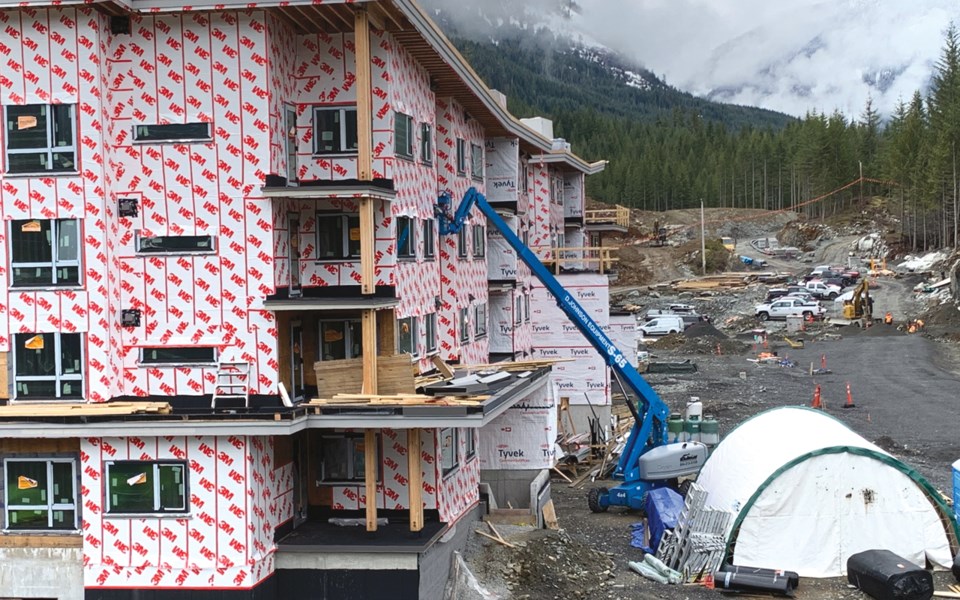An update on Whistler’s Balance Model presented to the Committee of the Whole on June 7 painted a picture of a municipality that is expected to continue rapidly growing—in both residents and daily tourists—over the next decade.
The Balance Model is a long-term strategic planning initiative that was created to balance the four “pillars” of Whistler’s vision—community, environment, tourism economy and sense of place.
“[The goal of the balance model] is linking all aspects of a resort tourism community, from the resident population, visitor population and the associated workforce and how that impacts the goals and the social and environmental indicators,” said the Resort Municipality of Whistler’s (RMOW) manager of economic development and tourism recovery Toni Metcalf.
According to the report, Whistler has seen a significant rebound following the COVID-19 pandemic, and tourism has returned stronger than when the pandemic started. This tourism growth has contributed to residents feeling increased pressures, including access and affordability challenges.
The Balance Model report analysis was designed to answer questions about whether Whistler’s capacity is currently constrained or underutilized, and what impacts population changes will have on the community.
Whistler currently has a relatively small population of about 14,000. If tourists and seasonal residents are taken into account, that number jumps to a population equivalent of about 40,000 people in the resort at any given time: 14,000 year-round residents; 5,000 seasonal residents; 16,000 overnight visitors; and 5,000 day-trippers from other parts of the province.
Balance Model projections show that Whistler’s population equivalent will continue to increase in the coming years if current historical trends continue.
Growth outside of the resort will also continue to affect the municipality, as the relationship between Whistler and the Lower Mainland continues to be intrinsically linked.
“On average, for every 100,000 person increase in the Lower Mainland, Whistler has seen close to 400 additional visitors staying overnight. For every one million additional YVR airport arrivals, Whistler has seen, on average, an additional 300 destination visitors per day,” said Metcalf.
Another trend the municipality expects to continue is the underutilization of market housing.
“From our housing survey that we ran in December 2021, we understand that 50 per cent of market dwellings are occupied by full-time residents, but we also found that 40 per cent of the bed units aren’t utilized,” said RMOW strategy analyst Becca Zalmanowitz.
There are about 62,000 bed units in the municipality, including tourist accommodation. Nearly half of these bed units, or 33,000, are residential. The report estimates about 5,000 people in the Whistler workforce live in market homes (for context, pre-pandemic, Whistler’s total full-time equivalent workforce was estimated to be about 16,300).
“As we grow into this capacity, we’re finding that our current peak days in terms of visitation could become the year-round average. So our current average is around 16,000 visitors per day, and that could grow to 22,000 overnight visitors per day,” said Zalmanowitz.
“So for a reference point, we’ve seen close to 22,000 per day in our peak months, so thinking January in 2019—now in our forecast, we’re saying that’s going to happen on an average basis year-round.”
Day-trippers are also expected to grow substantially, nearly doubling within the next few years. The report also predicts Whistler’s resident population will continue to grow in the coming years, with an additional 2,000 permanent residents and another 1,000 temporary residents. The Balance Model predicts a total population of about 22,000 people by 2040, which is around the same population White Rock and Squamish currently have.
“So combining all these segments together, our day-trippers, our workforce, our overnight guests, the Balance Model predicts that we’re going to go from a daily equivalent of about 40,000 people to a daily equivalent of about 50,000, on average,” said Zalmanowitz.
But while both overnight and day-trip visits are expected to grow substantially, Whistler’s workforce population will grow slower due to housing constraints.
Due to the lack of bed-unit capacity, workforce shortages are expected to rise to even more severe levels than what is currently being experienced. Over the next 18 years, the shortage of bed units could grow into the thousands.
“So without continued management or interventions, our current workforce shortage will grow to 15 per cent by 2040, equivalent to nearly 2,000 people. In terms of childcare needed, that would need to be about 200 licensed childcare spaces to meet the targets we have set for ourselves that we are currently not meeting, as well as keep pace with the current growth of the resident population,” said Zalmanowitz.
“Environmentally, we will exceed our target for passenger vehicle emissions, even when electric cars are taken into account, because highway traffic will keep rising and traffic congestion will rise by 50 per cent by 2040.”
The report estimates that the increased traffic could result in an additional two hours of congestion per day. “Congestion” in Whistler is defined as more than 1,000 vehicles on the highway at once, which is when Whistler usually sees the slowdown in traffic.
Another worrying trend is Whistler’s aging population. As more of the local workforce retires to their employee-restricted homes, this will increase younger workers’ reliance on market housing by up to 20 per cent, as the active workforce will be squeezed out of the restricted employee housing. Currently, Whistler only has one 55+ senior housing restricted building, which was built-in 2019.
With Phase 2 of the Balance Model initiative complete, the RMOW will now move to the "strategies and actions" phase, with more community consultation to follow.
Find more info at whistler.ca/balancemodel.





